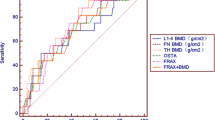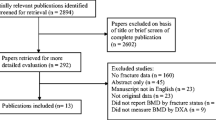Abstract
Summary
We assessed the ability of the World Health Organization’s fracture risk assessment tool (FRAX), bone mineral density (BMD), and age to discriminate fracture status in adults with pre-dialysis chronic kidney disease (CKD). In adults with CKD, FRAX was able to discriminate fracture status but performed no better than BMD alone.
Introduction
Patients with CKD are at increased risk for fracture but the best method to assess fracture risk is not known.
Methods
We assessed the ability of the World Health Organization’s FRAX, compared with BMD at the femoral neck (FN), and age to discriminate fracture status (prevalent clinical nonspine and/or morphometric vertebral) in men and women, 18 years and older with pre-dialysis CKD. Results are presented as area under receiver operator characteristic curves (AUC) with 95 % confidence intervals (CI).
Results
We enrolled 353 subjects; mean age was 65 ± 14 years; weight was 79 ± 18 kg, and estimated glomerular filtration rate was 28 ml/min/1.73 m2. About one third of the subjects had a prevalent clinical nonspine and/or morphometric vertebral fracture. FRAX was able to discriminate among those with prevalent clinical nonspine fractures (AUC, 0.72; 95 % CI, 0.65–0.78), morphometric vertebral fractures (AUC, 0.66; 95 % CI, 0.59–0.73), and any fracture (AUC, 0.71; 95 % CI, 0.65–0.77). The discriminative ability of BMD at the FN alone was similar to FRAX for morphometric vertebral and any fractures; FRAX performed better than BMD for prevalent clinical nonspine fractures (AUC for BMD alone, 0.66; 95 % CI, 0.60–0.73). Compared to FRAX, the AUC for age alone was lower for all fracture types.
Conclusions
Among men and women with CKD, FRAX is able to discriminate fracture status but performs no better than BMD alone.
Similar content being viewed by others
References
Nickolas TL, McMahon DJ, Shane E (2006) Relationship between moderate to severe kidney disease and hip fracture in the United States. J Am Soc Nephrol 17:3223–3232
Fried LF, Biggs ML, Shlipak MG, Seliger S, Kestenbaum B, Stehman-Breen C, Sarnak M, Siscovick D, Harris T, Cauley J, Newman AB, Robbins J (2007) Association of kidney function with incident hip fracture in older adults. J Am Soc Nephrol 18:282–286
Dooley AC, Weiss NS, Kestenbaum B (2008) Increased risk of hip fracture among men with CKD. Am J Kidney Dis 51:38–44
Alem AM, Sherrard DJ, Gillen DL, Weiss NS, Beresford SA, Heckbert SR, Wong C, Stehman-Breen C (2000) Increased risk of hip fracture among patients with end-stage renal disease. Kidney Int 58:396–399
Nitsch D, Mylne A, Roderick PJ, Smeeth L, Hubbard R, Fletcher A (2009) Chronic kidney disease and hip fracture-related mortality in older people in the UK. Nephrol Dial Transplant 24:1539–1544
Jamal S, Chase C, Goh Y, Richardson R, Hawker G (2002) Bone density and heel ultrasound testing do not identify patients with dialysis-dependent renal failure who have had fractures. AJKD 39:843–849
Yamaguchi T, Kanno E, Tsubota J, Shiomi T, Nakai M, Hattori S (1996) Retrospective study on the usefulness of radius and lumbar bone density in the separation of hemodialysis patients with fractures from those without fractures. Bone 19:549–555
Nickolas TL, Stein E, Cohen A, Thomas V, Staron RB, McMahon DJ, Leonard MB, Shane E (2010) Bone mass and microarchitecture in CKD patients with fracture. J Am Soc Nephrol 21:1371–1380
Yenchek RH, Ix JH, Shlipak MG, Bauer DC, Rianon NJ, Kritchevsky SB, Harris TB, Newman AB, Cauley JA, Fried LF (2012) Bone mineral density and fracture risk in older individuals with CKD. Clin J Am Soc Nephrol 7:1130–1136
Nickolas TL (2012) BMD and fracture risk in CKD: where should we go from here? Clin J Am Soc Nephrol 7:1058–1060
Piraino B, Chen T, Cooperstein L, Segre G, Puschett J (1988) Fractures and vertebral bone mineral density in patients with renal osteodystrophy. Clin Nephrol 30:57–62
Jamal SA, Hayden JA, Beyene J (2007) Low bone mineral density and fractures in long-term hemodialysis patients: a meta-analysis. Am J Kidney Dis 49:674–681
Urena P, Bernard-Poenaru O, Ostertag A, Baudoin C, Cohen-Solal M, Cantor T, de Vernejoul MC (2003) Bone mineral density, biochemical markers and skeletal fractures in haemodialysis patients. Nephrol Dial Transplant 18:2325–2331
Rix M, Andreassen H, Eskildsen P, Bente L, Olgaard K (1999) Bone mineral density and biochemical markers of bone turnover in patients with predialysis chronic renal failure. Kidney Int 56:1084–1093
Nickolas TL, Leonard MB, Shane E (2008) Chronic kidney disease and bone fracture: a growing concern. Kidney Int 74:721–731
(2008) FRAX WHO Fracture Risk Asssessment Tool. In. World Health Organization, Geneva, Switzerland
Jamal SA, Gilbert J, Gordon C, Bauer DC (2006) Cortical PQCT measures are associated with fractures in dialysis patients. J Bone Miner Res 21:543–548
Levey AS, Bosch JP, Lewis JB, Greene T, Rogers N, Roth D (1999) A more accurate method to estimate glomerular filtration rate from serum creatinine: a new prediction equation. Modification of diet in renal disease study group. Ann Intern Med 130:461–470
National Kidney Foundation (2002) K/DOQI clinical practice guidelines for chronic kidney disease: evaluation, classification, and stratification. Am J Kidney Dis 39:S1–266
(1994) Assessment of osteoporotic fracture risk and its role in screening for postmenopausal osteoporosis. WHO Technical Series Geneva
Genant HK, Jergas M (2003) Assessment of prevalent and incident vertebral fractures in osteoporosis research. Osteoporos Int 14:S43–S55
Kanis JA, Johnell O, De Laet C, Jonsson B, Oden A, Ogelsby AK (2002) International variations in hip fracture probabilities: implications for risk assessment. J Bone Miner Res 17:1237–1244
Kanis JA, Oden A, Johnell O, Johansson H, De Laet C, Brown J, Burckhardt P, Cooper C, Christiansen C, Cummings S, Eisman JA, Fujiwara S, Gluer C, Goltzman D, Hans D, Krieg MA, La Croix A, McCloskey E, Mellstrom D, Melton LJ 3rd, Pols H, Reeve J, Sanders K, Schott AM, Silman A, Torgerson D, van Staa T, Watts NB, Yoshimura N (2007) The use of clinical risk factors enhances the performance of BMD in the prediction of hip and osteoporotic fractures in men and women. Osteoporos Int 18:1033–1046
Leslie WD, Lix LM, Johansson H, Oden A, McCloskey E, Kanis JA (2010) Independent clinical validation of a Canadian FRAX((R)) tool: fracture prediction and model calibration. J Bone Miner Res 25:2350–2358
Fontaine MA, Albert A, Dubois B, Saint-Remy A, Rorive G (2000) Fracture and bone mineral density in hemodialysis patients. Clin Nephrol 54:218–226
Jamal SA, Cheung AM, West SL, Lok CE (2012) Bone mineral density by DXA and HR pQCT can discriminate fracture status in men and women with stages 3 to 5 chronic kidney disease. Osteoporos Int 23:2805–2813
Nickolas TL, Cremers S, Zhang A, Thomas V, Stein E, Cohen A, Chauncey R, Nikkel L, Yin MT, Liu XS, Boutroy S, Staron RB, Leonard MB, McMahon DJ, Dworakowski E, Shane E (2011) Discriminants of prevalent fractures in chronic kidney disease. J Am Soc Nephrol 22:1560–1572
Sakhaee K, Gonzalez GB (1999) Update on renal osteodystrophy: pathogenesis and clinical management. Am J Med Sci 317:251–260
Jamal SA (2010) Bone mass measurements in men and women with chronic kidney disease. Curr Opin Nephrol Hypertens 19:343–348
Stehman-Breen CO, Sherrard DJ, Alem AM, Gillen DL, Heckbert SR, Wong CS, Ball A, Weiss NS (2000) Risk factors for hip fracture among patients with end-stage renal disease. Kidney Int 58:2200–2205
Acknowledgments
The Toronto site was supported by grants from The Kidney Foundation of Canada, The Physicians’ Services Incorporated Foundation, and the Canadian Institutes of Health Research (FRN: 93785). The New York site was supported by grants from the National Institutes of Health (K23 DK080139); Amgen, Young Investigator Award; and the International Society for Clinical Densitometry, Special Projects Award and a Columbia University Herbert Irving Scholar Award.
Conflicts of interest
None.
Author information
Authors and Affiliations
Corresponding author
Rights and permissions
About this article
Cite this article
Jamal, S.A., West, S.L. & Nickolas, T.L. The clinical utility of FRAX to discriminate fracture status in men and women with chronic kidney disease. Osteoporos Int 25, 71–76 (2014). https://doi.org/10.1007/s00198-013-2524-1
Received:
Accepted:
Published:
Issue Date:
DOI: https://doi.org/10.1007/s00198-013-2524-1




